Page 332 of 539
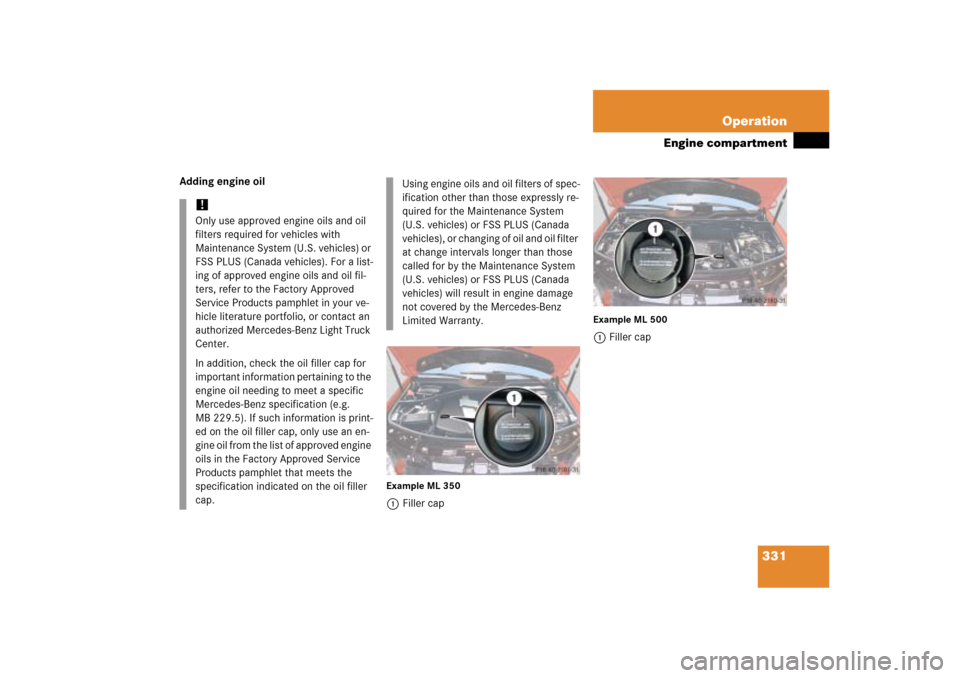
331 Operation
Engine compartment
Adding engine oil
Example ML 3501Filler cap
Example ML 5001Filler cap
!Only use approved engine oils and oil
filters required for vehicles with
Maintenance System (U.S. vehicles) or
FSS PLUS (Canada vehicles). For a list-
ing of approved engine oils and oil fil-
ters, refer to the Factory Approved
Service Products pamphlet in your ve-
hicle literature portfolio, or contact an
authorized Mercedes-Benz Light Truck
Center.
In addition, check the oil filler cap for
important information pertaining to the
engine oil needing to meet a specific
Mercedes-Benz specification (e.g.
MB 229.5). If such information is print-
ed on the oil filler cap, only use an en-
gine oil from the list of approved engine
oils in the Factory Approved Service
Products pamphlet that meets the
specification indicated on the oil filler
cap.
Using engine oils and oil filters of spec-
ification other than those expressly re-
quired for the Maintenance System
(U.S. vehicles) or FSS PLUS (Canada
vehicles), or changing of oil and oil filter
at change intervals longer than those
called for by the Maintenance System
(U.S. vehicles) or FSS PLUS (Canada
vehicles) will result in engine damage
not covered by the Mercedes-Benz
Limited Warranty.
Page 333 of 539
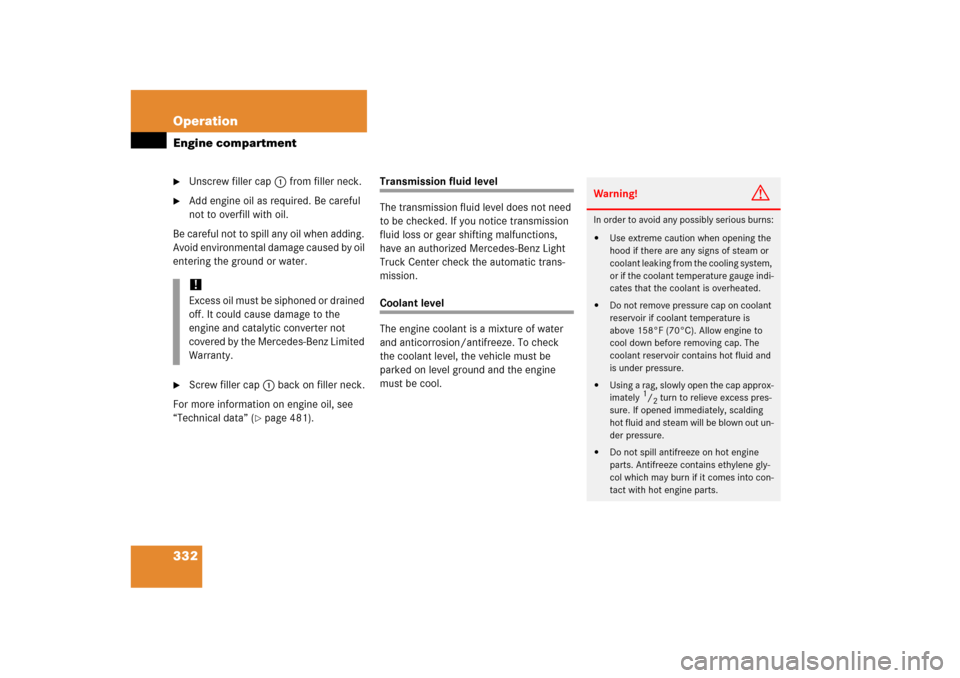
332 OperationEngine compartment�
Unscrew filler cap1 from filler neck.
�
Add engine oil as required. Be careful
not to overfill with oil.
Be careful not to spill any oil when adding.
Avoid environmental damage caused by oil
entering the ground or water.
�
Screw filler cap1 back on filler neck.
For more information on engine oil, see
“Technical data” (
�page 481).
Transmission fluid level
The transmission fluid level does not need
to be checked. If you notice transmission
fluid loss or gear shifting malfunctions,
have an authorized Mercedes-Benz Light
Truck Center check the automatic trans-
mission.Coolant level
The engine coolant is a mixture of water
and anticorrosion/antifreeze. To check
the coolant level, the vehicle must be
parked on level ground and the engine
must be cool.
!Excess oil must be siphoned or drained
off. It could cause damage to the
engine and catalytic converter not
covered by the Mercedes-Benz Limited
Warranty.
Warning!
G
In order to avoid any possibly serious burns:�
Use extreme caution when opening the
hood if there are any signs of steam or
coolant leaking from the cooling system,
or if the coolant temperature gauge indi-
cates that the coolant is overheated.
�
Do not remove pressure cap on coolant
reservoir if coolant temperature is
above 158°F (70°C). Allow engine to
cool down before removing cap. The
coolant reservoir contains hot fluid and
is under pressure.
�
Using a rag, slowly open the cap approx-
imately
1/2 turn to relieve excess pres-
sure. If opened immediately, scalding
hot fluid and steam will be blown out un-
der pressure.
�
Do not spill antifreeze on hot engine
parts. Antifreeze contains ethylene gly-
col which may burn if it comes into con-
tact with hot engine parts.
Page 370 of 539
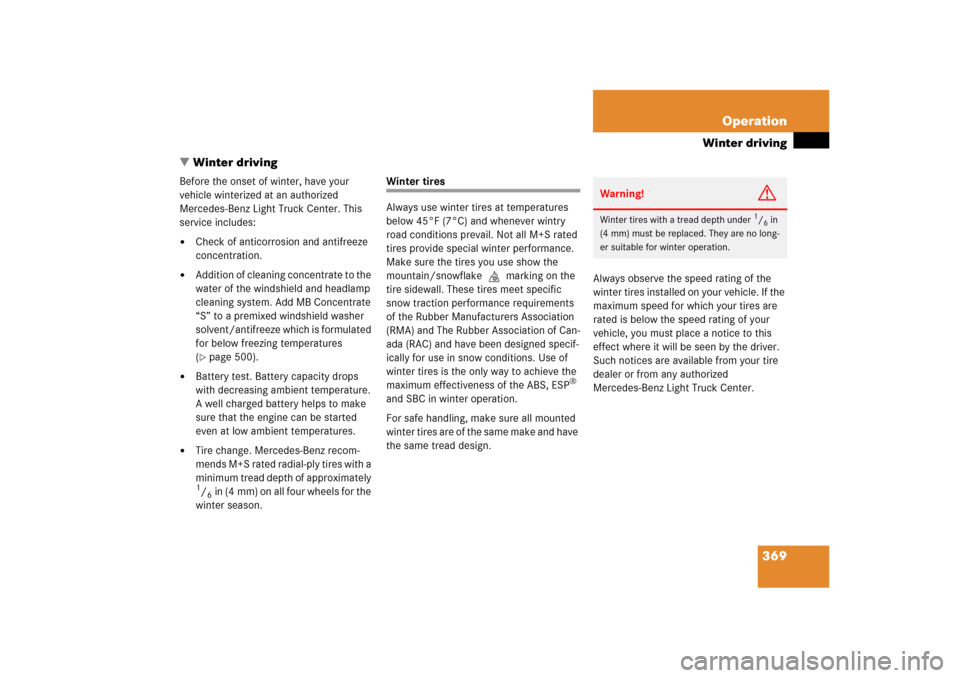
369 Operation
Winter driving
�Winter driving
Before the onset of winter, have your
vehicle winterized at an authorized
Mercedes-Benz Light Truck Center. This
service includes:�
Check of anticorrosion and antifreeze
concentration.
�
Addition of cleaning concentrate to the
water of the windshield and headlamp
cleaning system. Add MB Concentrate
“S” to a premixed windshield washer
solvent/antifreeze which is formulated
for below freezing temperatures
(�page 500).
�
Battery test. Battery capacity drops
with decreasing ambient temperature.
A well charged battery helps to make
sure that the engine can be started
even at low ambient temperatures.
�
Tire change. Mercedes-Benz recom-
mends M+S rated radial-ply tires with a
minimum tread depth of approximately 1/6in (4 mm) on all four wheels for the
winter season.
Winter tires
Always use winter tires at temperatures
below 45°F (7°C) and whenever wintry
road conditions prevail. Not all M+S rated
tires provide special winter performance.
Make sure the tires you use show the
mountain/snowflake.marking on the
tire sidewall. These tires meet specific
snow traction performance requirements
of the Rubber Manufacturers Association
(RMA) and The Rubber Association of Can-
ada (RAC) and have been designed specif-
ically for use in snow conditions. Use of
winter tires is the only way to achieve the
maximum effectiveness of the ABS, ESP
®
and SBC in winter operation.
For safe handling, make sure all mounted
winter tires are of the same make and have
the same tread design.Always observe the speed rating of the
winter tires installed on your vehicle. If the
maximum speed for which your tires are
rated is below the speed rating of your
vehicle, you must place a notice to this
effect where it will be seen by the driver.
Such notices are available from your tire
dealer or from any authorized
Mercedes-Benz Light Truck Center.
Warning!
G
Winter tires with a tread depth under
1/6in
(4 mm) must be replaced. They are no long-
er suitable for winter operation.
Page 371 of 539
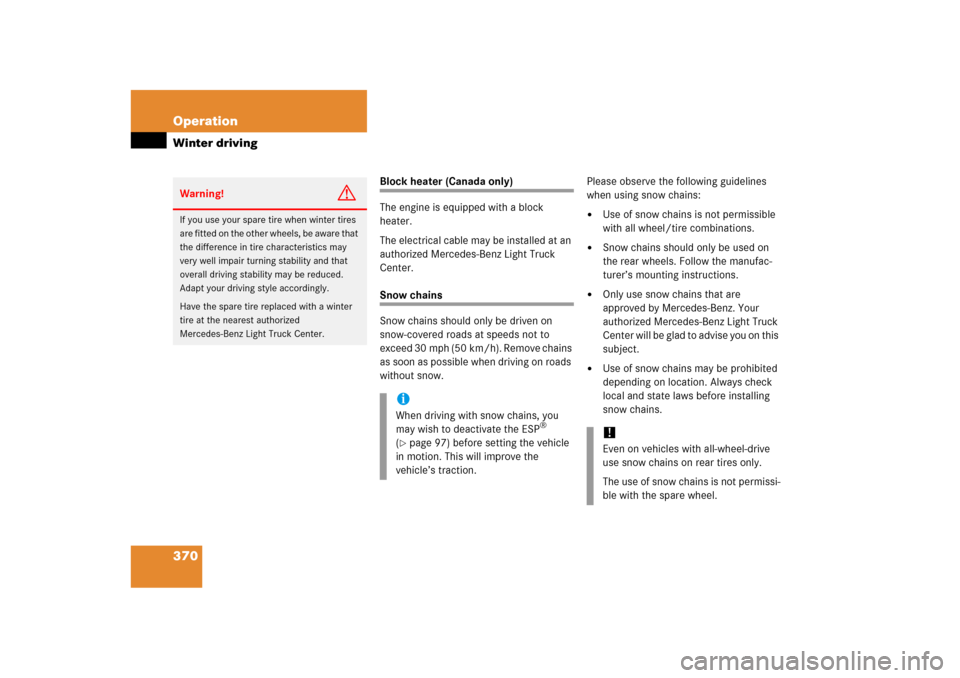
370 OperationWinter driving
Block heater (Canada only)
The engine is equipped with a block
heater.
The electrical cable may be installed at an
authorized Mercedes-Benz Light Truck
Center.Snow chains
Snow chains should only be driven on
snow-covered roads at speeds not to
exceed 30 mph (50 km/h). Remove chains
as soon as possible when driving on roads
without snow.Please observe the following guidelines
when using snow chains:
�
Use of snow chains is not permissible
with all wheel/tire combinations.
�
Snow chains should only be used on
the rear wheels. Follow the manufac-
turer’s mounting instructions.
�
Only use snow chains that are
approved by Mercedes-Benz. Your
authorized Mercedes-Benz Light Truck
C e n t e r w i l l b e g l a d t o a d v i s e y o u o n t h i s
subject.
�
Use of snow chains may be prohibited
depending on location. Always check
local and state laws before installing
snow chains.
Warning!
G
If you use your spare tire when winter tires
are fitted on the other wheels, be aware that
the difference in tire characteristics may
very well impair turning stability and that
overall driving stability may be reduced.
Adapt your driving style accordingly.
Have the spare tire replaced with a winter
tire at the nearest authorized
Mercedes-Benz Light Truck Center.
iWhen driving with snow chains, you
may wish to deactivate the ESP
®
(
�page 97) before setting the vehicle
in motion. This will improve the
vehicle’s traction.
!Even on vehicles with all-wheel-drive
use snow chains on rear tires only.
The use of snow chains is not permissi-
ble with the spare wheel.
Page 383 of 539
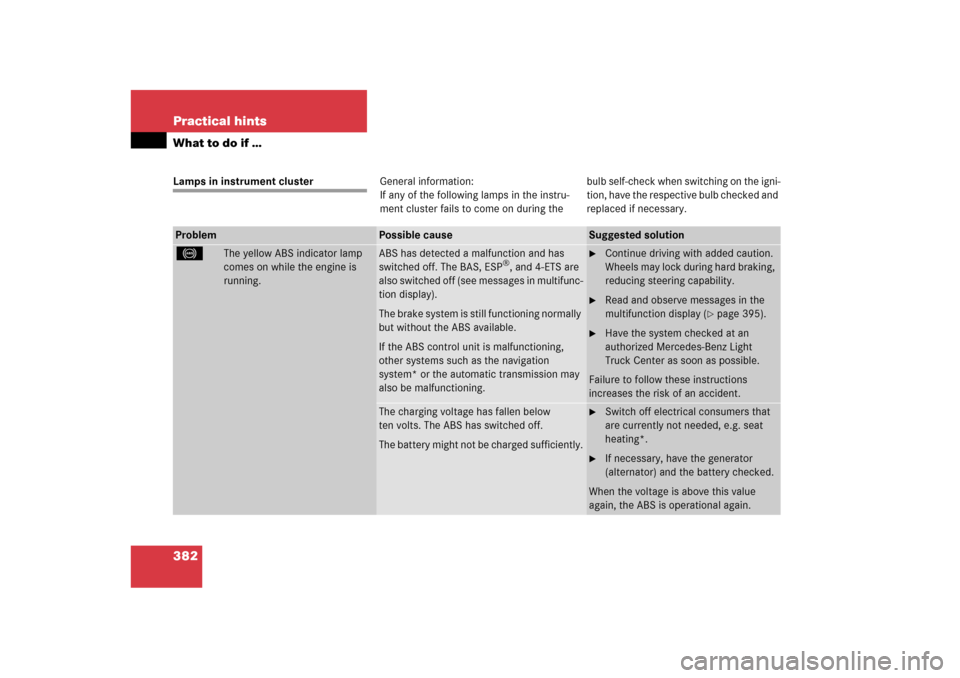
382 Practical hintsWhat to do if …Lamps in instrument clusterGeneral information:
If any of the following lamps in the instru-
ment cluster fails to come on during thebulb self-check when switching on the igni-
tion, have the respective bulb checked and
replaced if necessary.Problem
Possible cause
Suggested solution
-
The yellow ABS indicator lamp
comes on while the engine is
running.
ABS has detected a malfunction and has
switched off. The BAS, ESP
®, and 4-ETS are
also switched off (see messages in multifunc-
tion display).
The brake system is still functioning normally
but without the ABS available.
If the ABS control unit is malfunctioning,
other systems such as the navigation
system* or the automatic transmission may
also be malfunctioning.
�
Continue driving with added caution.
Wheels may lock during hard braking,
reducing steering capability.
�
Read and observe messages in the
multifunction display (
�page 395).
�
Have the system checked at an
authorized Mercedes-Benz Light
Truck Center as soon as possible.
Failure to follow these instructions
increases the risk of an accident.
The charging voltage has fallen below
ten volts. The ABS has switched off.
The battery might not be charged sufficiently.
�
Switch off electrical consumers that
are currently not needed, e.g. seat
heating*.
�
If necessary, have the generator
(alternator) and the battery checked.
When the voltage is above this value
again, the ABS is operational again.
Page 386 of 539
385 Practical hints
What to do if …
Problem
Possible cause
Suggested solution
?
(USA only)
±
(Canada only)
The yellow engine malfunction
indicator lamp comes on while
driving.
There is a malfunction in:�
The fuel management
system
�
The ignition system
�
The emission control
system
�
Systems which affect
emissions
Such malfunctions may result
in excessive emissions values
and may switch the engine to
its limp-home (emergency op-
eration) mode (
�page 192).
�
Have the vehicle checked as soon as
possible by an authorized
Mercedes-Benz Light Truck Center.
An on-board diagnostic connector is
used by the service station to link the
vehicle to the shop diagnostics
system. It allows the accurate identifi-
cation of system malfunctions through
the readout of diagnostic trouble
codes. It is located in the front left area
of the footwell next to the parking
brake pedal.
Page 387 of 539
386 Practical hintsWhat to do if …Problem
Possible cause
Suggested solution
?
(USA only)
±
(Canada only)
The yellow engine malfunction
indicator lamp comes on while
driving.
A loss of pressure has been
detected in the fuel system.
The fuel cap may not be closed
properly or the fuel system
may be leaky.
�
Check the fuel cap (
�page 323).
If it is not closed properly:
�
Close the fuel cap.
If it is closed properly:
�
Have the fuel system checked by an
authorized Mercedes-Benz Light Truck
Center.
Your fuel tank is empty.
�
After refueling start, turn off and
restart the engine three or four times in
succession.
The limp-home mode is canceled. You do
not need to have your vehicle checked.
Page 388 of 539
387 Practical hints
What to do if …
Problem
Possible cause
Suggested solution
v
The yellow ESP
® warning lamp
comes on while the engine is
running.
The ESP
® is deactivated.
Risk of accident!
Adapt your speed and driving to the prevail-
ing road, weather, and traffic conditions.
�
Switch the ESP
® back on (
�page 98).
If the ESP
® cannot be switched back on,
have the system checked at an autho-
rized Mercedes-Benz Light Truck Center
as soon as possible.
v
The yellow ESP
® warning lamp
flashes while driving.
The ESP
® or traction control has come into
operation because of detected traction loss
of at least one tire.
�
When driving off, apply as little throt-
tle as possible.
�
While driving, ease up on the acceler-
ator.
�
Adapt your speed and driving to the
prevailing road and weather condi-
tions.
�
Do not deactivate the ESP
®.
Exceptions: (
�page 97).
Failure to follow these instructions in-
creases the risk of an accident.